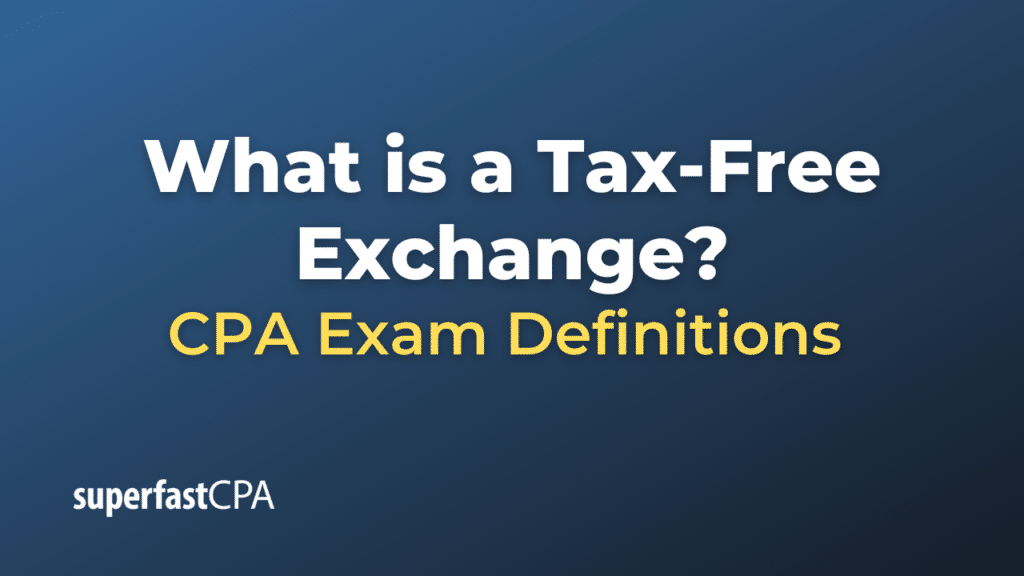Tax-Free Exchange
A tax-free exchange, often referred to as a “like-kind exchange” or a “1031 exchange” (based on Section 1031 of the U.S. Internal Revenue Code), allows an investor to defer paying capital gains taxes on the sale of a property if they reinvest the proceeds into a similar, or “like-kind,” property. The primary purpose is to allow taxpayers to reinvest into a similar asset without immediately incurring a tax liability.
Some key points about tax-free (like-kind) exchanges:
- Like-Kind Property: The term “like-kind” pertains to the nature or character of the property rather than its grade or quality. For instance, you can exchange an apartment building for a ranch or a piece of undeveloped land, as they are all considered real estate. Prior to the Tax Cuts and Jobs Act of 2017, personal properties could also qualify for like-kind exchanges. Still, post-2017, only real estate properties qualify.
- Held for Productive Use or Investment : Both properties, the one being sold (relinquished) and the one being acquired (replacement), must be held for business or investment purposes.
- Deferred Taxes, Not Tax-Free: It’s important to note that the taxes on capital gains are deferred, not eliminated. If the new property is later sold without a subsequent like-kind exchange, then the taxes will be due.
- Timeframe for the Exchange: After selling the relinquished property, there are two critical time frames to remember:
- Use of an Intermediary : The investor can’t receive the sale proceeds directly. Instead, they use a qualified intermediary, a third-party facilitator, to hold onto the funds and buy the replacement property on their behalf.
- Boot: If an investor doesn’t reinvest all proceeds from the sale or if the mortgage on the replacement property is less than the mortgage on the relinquished property, this difference is termed as “boot.” The investor may have to pay taxes on the boot.
Example of a Tax-Free Exchange
Let’s delve into a detailed hypothetical example to understand a 1031 tax-free exchange.
Scenario:
James owns a rental property (Property A) in the city that he purchased 10 years ago for $300,000. Over the years, the property’s value has appreciated, and it’s now worth $500,000. If he sells this property, he would realize a capital gain of $200,000. Assuming a capital gains tax rate of 15%, he would owe $30,000 in taxes.
However, James is interested in another rental property (Property B) located by the beach, which is listed for $480,000. Instead of selling Property A, paying taxes, and then purchasing Property B, he decides to go with a 1031 tax-free exchange.
Steps James Takes:
- Engage a Qualified Intermediary: Before selling Property A, James contacts a qualified intermediary (QI) to facilitate the 1031 exchange. The QI will handle the proceeds from the sale to ensure James doesn’t have “constructive receipt” of the funds, which would invalidate the tax-free exchange.
- Sell Property A: James sells Property A for $500,000. Instead of taking the proceeds, the money is transferred to the QI’s account.
- Identification of Replacement Property: Within 45 days of selling Property A, James identifies Property B by the beach as the replacement property and notifies the QI in writing.
- Purchase of Replacement Property: The QI uses the $500,000 in their account to purchase Property B on James’s behalf. Since Property B costs $480,000, there’s an excess of $20,000.
- Handling the Excess Funds: The $20,000 excess, termed as “boot,” is given to James after the purchase of Property B. This amount is taxable, as it wasn’t used to buy like-kind property.
Outcome:
- James successfully deferred paying capital gains tax on the appreciation of Property A by using the 1031 exchange.
- However, he would need to pay taxes on the $20,000 boot, as it wasn’t reinvested into like-kind property.
- The basis of Property A is transferred to Property B. If James decides to sell Property B in the future without another like-kind exchange, he would owe taxes on the deferred gains and any additional appreciation of Property B.
It’s important to remember that this example simplifies a process that has more detailed rules and specific time frames. If considering a 1031 exchange, one should consult with tax professionals or legal experts.













